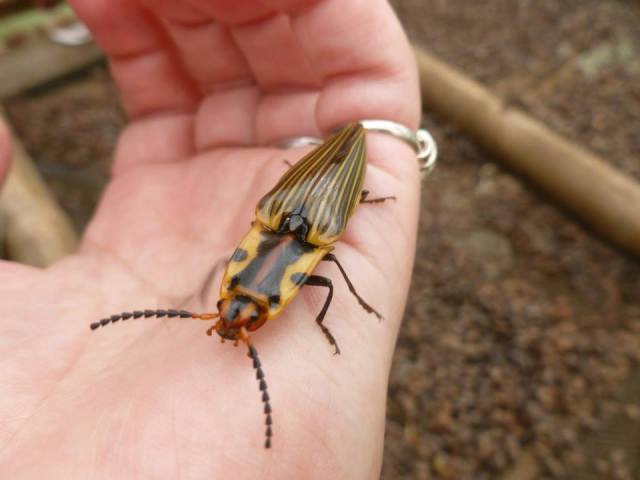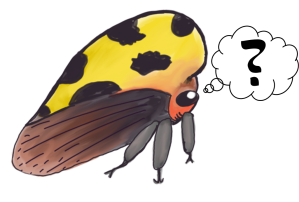Written by Nancy Miorelli
The short answer is “No.”
The long answer is “No.” but with with a bit more explanation. The first is that I’m a communicator, an ecologist, and don’t have a lot of the proper equipment.
Have I seen a new species to science? I have absolutely no doubt. Did I know it was a new species when I saw it? No, probably not. There’s just so much diversity here it hasn’t even been quantified.

Our moth sheet in Ecuador. So yeah there’s probably a dozen or so new species on it. Anyone want to look at really tiny brown moths?
For example. There’s about ~20,000 species of butterflies in the world. Ecuador has close to 4,000 butterfly species. Maqui, the reserve that I’m in, has close to 200 butterfly species. So our one little 6,000 hectare (15,000 acre) reserve has 0.5% of the butterfly species of Ecuador! And that’s just butterflies – a big charismatic group that has a lot of identification work in it. Beetles, moths, and little wasps on the other hand are a whole nother animal(s). There’s a lot more of them, an there’s a lot more little ones, and a lot more that live in tropical areas that are hard to get to.
I’m Not a Taxonomist
Nope. I’m a communicator and an ecologist. I study big picture things – how organisms are working in the environment and how they interact with each other. Taxonomy is studying evolutionary relationships, placing organisms into nice categories like families or species, and naming new organisms. I definitely have an interest in this, but it’s not my specialty.
I took a taxonomy class for my Master’s degree, but even in that class we just identified insects down to family and not down to species. So while I’m pretty good at telling you that your insect is a beetle, and a click beetle at that, I probably couldn’t tell you that it’s a Semiotus bispinus.
Even If I Were a Taxonomist
There’s just too many bugs! We’ve talked about it before, but there’s just no way that one human can know all of 58% percent of the known biodiversity on the planet. Try memorizing 1,000,000 species. It’s just not possible for one human brain.
Professional taxonomists can’t do it either. They’re not (yet) superhuman. That’s why they specialize in one group. I have several taxonomy friends that help me out a lot but each one specializes. One focuses on beetles. Another focuses on fly taxonomy, and another focuses just on millipedes, and another just on wasps. Another on ants, and yet another on katydids. Within those groups, they specialize even further. Morgan studies a small family of stilt-legged flies. Miles studies parasitic wasps. Tommy studies little tiny brown monotomid beetles. Derek works on millipedes (they need a lot of work). Alex Wild not only takes great ant photos but can tell you anything you want to know about them. Piotr Naskrecki will show you the beauty of katydids and then tell you all the cool stuff about them. There’s of course like a billion people I left out who all have their specialties. (Message me, I’ll put you in the list. I appreciate you taxonomists!)

PC: Alex Wild (Public Domain)
If you ask any of them how they do it, they’ll respond with lots of time hunched over high powered microscopes and probably dissecting out genitalia. (I don’t have access to high powered, sensitive to humidity, mold, and dust, in the rain forest. For obvious reasons.)
And we’re all pretty good at general family level ID’s. But if you ask a beetle person about an obscure genus of moth, they’re most likely going to respond with, “¯\_(ツ)_/¯ .” Or subsequently a moth person about a katydid genus, and a katydid person about a millipede genus, they’re all probably going to respond with “I’m not an expert in that field, but here are some places of people to talk to.” This is what makes sites like BugGuide so successful! All the experts are lurking around just waiting to ID the critters. There are a few people like Doug Yanega and Floyd Shockley who seem to know just about everything. But they’ve had a long time and a lot of practice (and maybe are superhuman).
I’m not an expert in anything, so with the exception of a few token species, I’m also likely to respond with “¯\_(ツ)_/¯” when asked because I really just don’t know. Especially in Ecuador, one of 17 megadiverse countries and one of the top 5 biodiversity hotspots. There’s just not many good references. I’ve gotten pretty good with local butterflies since I have a good book for them and Andreas Kay runs a wonderful Flickr account, but everything else I feel pretty useless.

And don’t even get us started on larva or caterpillars.
PC: Andreas Kay (CC BY-NC-CA 2.0)
New Species
Have I seen a new species to science? I’m sure!
Did I know it was a new species to science? No.
Since I don’t have a specialized knowledge in any group, I can’t look at something and say “That looks special or different.” And so I have no red flags to go off to possibly catch it, or take pictures, or send it to someone. I don’t even know who I’d send it to since getting import and export permits are difficult. For some reason no one wants potential insects getting loose and eating all their crops.
TL;DR
No I haven’t discovered a new species despite my year of living in the rain forest. I’m an ecologist and not a taxonomist. I can tell you generally what bugs are, and their function in the ecosystem, but I can’t tell you down to species without a book or someone who knows what they’re talking about. But maybe one of you lovely people wants to come out, look at a moth sheet with me, or dig through a dead log, and help put names to the vastly ignored insect groups.






the insects i have in my old mattress–first ones out small ones -some with wings and are white–others that are darker and are articulated. they can sting. as well as the ugly things that look like spiders from the front ,but have a light grey color with lots of silvery looking legs just below the head.these legs give a sting that you remember .you feel it for 15 seconds. the eyes are 2 small black dots. they are camouflaged and hard to see except for the (20) legs or so. they are carnivorous and eat the dead ones i kill with a fly swatter. when i do that–there appears to be a halo of protection to them that can also sting. they come out after 2am and go back in the mattress if it is daylight. three of them have charged me and got another swat. they are very fragile. the only ones i could get a sample of were the darker ones with wings. they all develop 2 wings on each side. —in a book they resemble SCORPION FLIES. the book said some 1,000 species exist and that some eat plants and others eat other insects. they stick to the blanket or sheet so you can not scoop any of them up for analysis. IF HOLLYWOOD EVER SAW THEM THEY WOULD BE PERFECT FOR A HORROR MOVIE. THEY ARE UGLY. ALL THEY HAVE TO DO IS MAKE THEM AS BIG AS PEOPLE. –YT. GORDON RUSCH–SILVER SPRING MD.
LikeLike
Please send us a picture at askentomologists@gmail.com
LikeLike